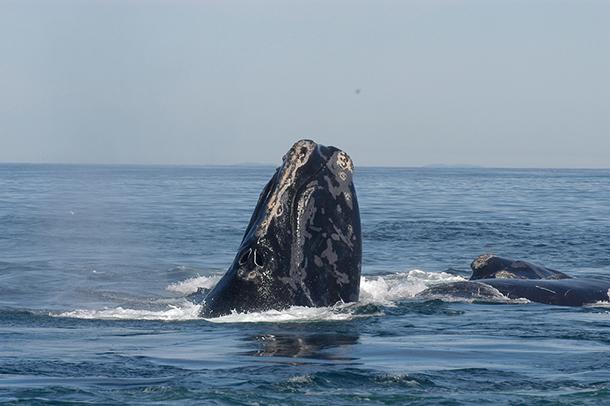Endangered right whales have moved because of climate change — into dangerous waters
North Atlantic right whales, an endangered species, usually spend their summers in and around the Gulf of Maine to feed on copepods.
At the Center for Coastal Studies in Provincetown, Christy Hudak, a researcher in the Right Whale Ecology Program, leaned over a microscope looking at a water sample, counting and categorizing different kinds of plankton.
“Right whales love a specific type of plankton, which are called copepods. They are more of a tiny crustacean plankton — think of crabs, or shrimp,” Hudak said.
For decades, endangered right whales spent summers in Canadian waters like the Bay of Fundy and the Roseway Basin, feasting on these copepods. But copepod numbers in those places have fallen in recent years.
“And so [North Atlantic right whales] left those areas because it just was not a rich source of food for them when they needed it,” Hudak said.
In 2017, researchers discovered North Atlantic right whales congregating farther north, in the Gulf of St. Lawrence — a place they’d rarely been recorded going. It’s an area that just happens to have highly trafficked shipping lanes.
In the last two years alone, 20 right whales have been found dead in Canadian waters. Of the 11 that could be necropsied and studied, seven were found to have died as a result of vessel strikes.
Researchers worry collisions with ships are increasingly to blame.
Sean Brillant, a biologist with the Canadian Wildlife Federation, says there’s an underlying cause putting whales in harm’s way.
“Climate change is almost definitely responsible for the change in distribution of the whales,” Brillant said.
That’s because the copepods are thriving in cooler waters farther north, as the Bay of Fundy and Roseway Basin have gotten too warm for them.
“I think that [the whales] are still sort of settling out and figuring out how they’re going to use the gulf and [find] the best food,” Brillant said. “And of course there’s a lot of variability from year to year. This makes it very challenging for managing our human activities.”
The first year they were found in the Gulf of St. Lawrence was a disastrous one for North Atlantic right whales. In 2017, 12 were found dead from ship strikes and entanglements.
In response, the Canadian government introduced new regulations to try to protect the whales, imposing temporary speed restrictions in areas where they were spotted.
“In 2018 they actually enacted really nice mitigation measures that seemed to help the whales fare a little bit better because there were no deaths in Canadian waters last year,” said Sarah Sharp, a veterinarian with the International Fund for Animal Welfare.
But this summer, already eight of the whales have been found dead, including two in the last week.
Sharp says this year has been so deadly for two reasons.
First, all of this is new, for whales and Canadian authorities alike.
“One of the big failures, unfortunately, this year was the whales were just in a different place than where they had been in previous years,” Sharp said. “And so what they had set up in terms of protections didn’t apply because that’s not where the whales were.”
They’re showing up just a little east, probably in search of food, putting them in the middle of shipping lanes.
The second reason for the spike in deaths, say whale advocates, has to do with the Canadian government’s response. They point to some of the 2018 speed restrictions Canadian authorities rolled back this year. In some areas, speed limits only applied after a whale was seen.
“The problem was that the weather had been bad all through June and survey effort was less than it was the summer of 2018,” according to Erica Fuller, a lawyer with the Conservation Law Foundation. “So in the absence of sighting a whale, the triggers often didn’t get triggered.”
Early in July, the Canadian government responded by introducing more seasonal regulations on speed, and added funding for surveillance.
Speed restrictions can be hard on the shipping industry, but Erica Fuller says that kind of sacrifice needs to be made to save the species.
“It may take slightly longer to get a product to port than it would in the absence of right whales. Well, we can’t lose any more whales from getting hit by ships,” Fuller said.
And there’s one more question: with rising ocean temperatures, will right whales again chase their favorite food into new waters — perhaps into the path of even greater danger?
With a population just over 400, the answer could be the difference between survival and extinction.
This story originally appeared on WGBH. This is the second of a two-part report explaining how vessel strikes happen, why they’re increasing and what’s being done to stop them. Read part one here.
